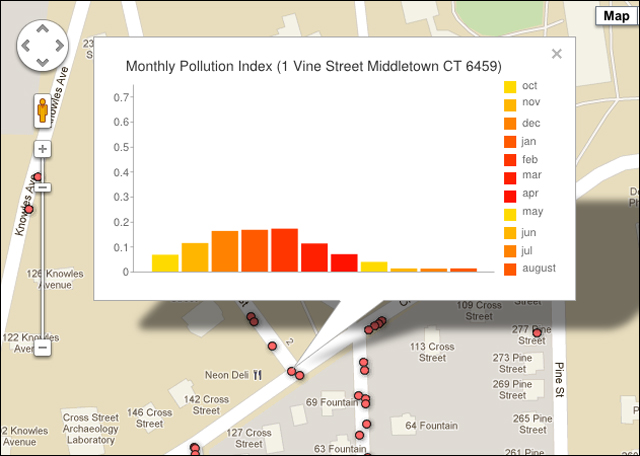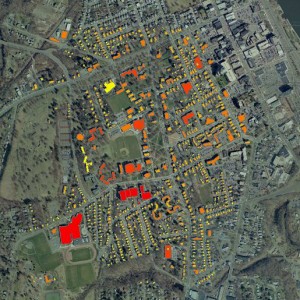Eco-Tools Map Campus Pollution, Promote Green Purchasing

To help members of the Wesleyan community be more aware of their environmental impact, the College of the Environment is developing practical and accessible Eco-Tools.
The Eco-Tools prototype, launched in April, provides links and information to Wesleyan’s current projects, the Wesleyan Eco-Map and the Wesleyan Eco-Purchasing site.
“Wesleyan is the first university in the country to create these tools,” explains project coordinator Mary Alice Haddad, associate professor of government, East Asian studies and environmental studies. “The project is just starting to bloom, but once we get it up and operating, it can act as a model for other universities.”

The Wesleyan Eco-Map highlights changes in energy usage in different buildings on campus over time, based solely on changes in human behavior. The prototype currently tracks the monthly pollution index for all wood-framed housing on campus, and in time, may track heat and water usage for the entire university.
“The biggest drive for pollution is who’s living in it,” says Bill Nelligan, director of environmental health, safety and sustainability. “The Eco-Map will provide a real visual for students living in these homes to see their energy use month to month, year to year, and make them think, “How can I improve?'”
The map shows that residents residing at 1 Vine Street used almost twice as much energy (hence, creating twice as much pollution) during the months of December, January and February, as they did in March, April and May. So, students who reside in the home in 2012-13 can monitor their own energy usage on the site, and compare it to the energy use in 2011-12.
Of course, there are environmental factors to take into account. Some homes are heated with gas; others are electric. Some are 4,000 square feet, others are half that size. Some homes, such as 19 and 20 Fountain Avenue and 231 Pine Street were constructed in the past 10 years, while the majority of homes are from the 1900s. And the roof of 19 Fountain Avenue is topped with solar panels.
Wesleyan’s second Eco-Tool, Wesleyan Eco-Purchasing, offers members of the Wesleyan community detailed information about the environmental impacts of the information technology products in use on campus. The site promotes responsible purchasing decisions and encourages companies to act in more environmentally and socially responsible ways.
“I.T. companies and their suppliers are among the worst polluters, but the government isn’t always monitoring or enforcing the environmental standards,” Haddad says.”We need to put pressure on these companies to clean up their act.”
Haddad and her students examined four of the most common and established ranking systems for IT suppliers: the Carbon Disclosure Project, EPEAT, Greenpeace, and Institute of Public and Environmental Affairs (IPE), and created a chart based on their green rankings.
The CDP, which collects greenhouse gas emissions data from Fortune 500 companies, found that the companies Philips, Sony, Samsung and Panasonic produce the lowest emissions. EPEAT, which ranks companies based on their ability to meet a host of environmental criteria regarding production, use, and disposal, reports that Apple, Toshiba and Lenovo offer the highest number of energy-efficient products.
This initiative hopes to help members of the Wesleyan community to make informed decisions about their behavior and to be more aware of the longer-term impacts of the products that they use on a daily basis. This not only applies to IT equipment, other supplies and services at the university, explains Olga Bookas, purchasing manager.
For example, the cups used at Commencement were compostable, Wesleyan’s copier/printers are made from re-sued parts and the university’s custodial vendor uses eco-friendly cleaning products.
“When I’m working with a new supplier, I always make sure that their products are eco-friendly, and I ask what are they doing to help the environment,” Bookas says. “It’s important that their suppliers are using sustainable products.”
The idea for Eco-Tools came about last year, when Haddad was in China working on her research. There, she met Wesleyan alumnus and Ted Plafker ’86, who introduced Haddad to Ma Jun, president of the Institute of Public and Environmental Affairs (IPE). Ma’s organization developed a pollution map that shows what areas in China are producing the highest amounts of nitrogen dioxide, industrial wastewater, domestic sewage, mercury, arsenic sulphur dioxide, and other particulate matters.
Last fall, Haddad invited Ma to Wesleyan, where he spoke to faculty, staff, students and administrators about his organization, eco-mapping, and pressuring industries to use green supply chains. Haddad was eager to find ways to collaborate with Ma, and the Wesleyan eco-tools project was born.
With a small grant from the COE, Haddad was able to support seven students who mapped GPS coordinates of university’s wood-framed housing and worked with staff in Information Technology Services to develop the web site and campus map. Within months, the Wesleyan prototype was up and running.
Haddad, who is currently writing an article on pollution mapping, says the project may be incorporated into a Quantitative Analysis Center project or used in her Fall 2012 seminar on Environmental Advocacy.
“Developing the Eco-Tools is so exciting because it’s such a collaborative effort,” she says. “We have the potential to make a big impact.”

